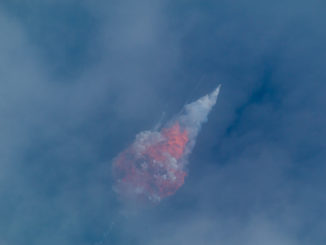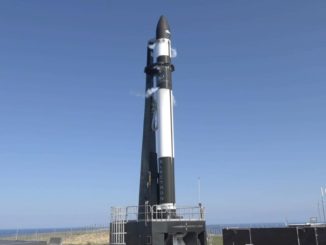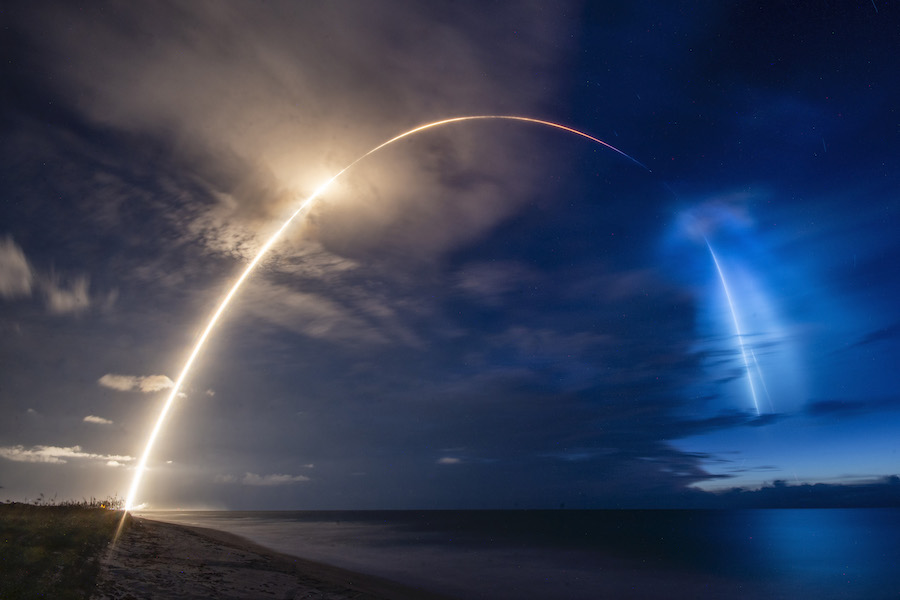
Breaking a SpaceX record for the shortest span between two missions from the same launch pad, a Falcon 9 rocket lifted off Saturday from Cape Canaveral carrying 58 more Starlink broadband satellites and three Earth-imaging spacecraft for Planet.
The Falcon 9 rocket roared into space from pad 40 at Cape Canaveral Air Force Station at 5:21:18 a.m. EDT (0921:18 GMT), heading to the northeast as it ascended into sunlight, creating a twilight spectacle visible for hundreds of miles.
SpaceX’s previous Falcon 9 launch took off from the same location less than 10 days before, the fastest turnaround between Falcon 9 flights from the same launch pad in the company’s history.
It was the third Falcon 9 launch in two weeks, and SpaceX has two more Falcon 9 rocket flights scheduled before the end of June.
Those missions are currently scheduled for launch from pad 39A at NASA’s Kennedy Space Center on June 22 — with another batch of Starlink satellites — and on June 30 from pad 40 again with a U.S. Space Force GPS navigation satellite.
After shutting down its nine main engines two-and-a-half minutes into the mission Saturday, the Falcon 9’s first stage dropped away and flipped around to fly tail first and descend to a propulsive landing on SpaceX’s drone ship floating in the Atlantic Ocean around 400 miles (630 kilometers) northeast of Cape Canaveral.
The Falcon 9’s second stage engine ignited to accelerate the 58 Starlink satellites and three SkySats into an orbit with an average altitude of nearly 200 miles (300 kilometers). The rocket’s nose cone also jettisoned to parachute into the Atlantic, where two other SpaceX recovery ships retrieved the two-piece fairing for return to Port Canaveral.
The first stage booster and fairing flown on Saturday’s mission were both recovered and reused from previous Falcon 9 missions.
Saturday’s launch was the first to fly secondary payloads to ride to orbit on SpaceX’s commercial rideshare service, which the company announced last year.
Planet, headquartered in San Francisco, was the first company to publicly confirm plans to utilize the rideshare launch service.
The launch of three Planet SkySat spacecraft Saturday will be followed by another Falcon 9/Starlink mission in July carrying Planet’s final three SkySats, capping off the deployment of the company’s fleet of 21 commercial high-resolution Earth observation satellites.
Mike Safyan, Planet’s vice president of launch, said SpaceX’s small satellite rideshare service was “a very attractive offering” to launch the company’s last six SkySat satellites.
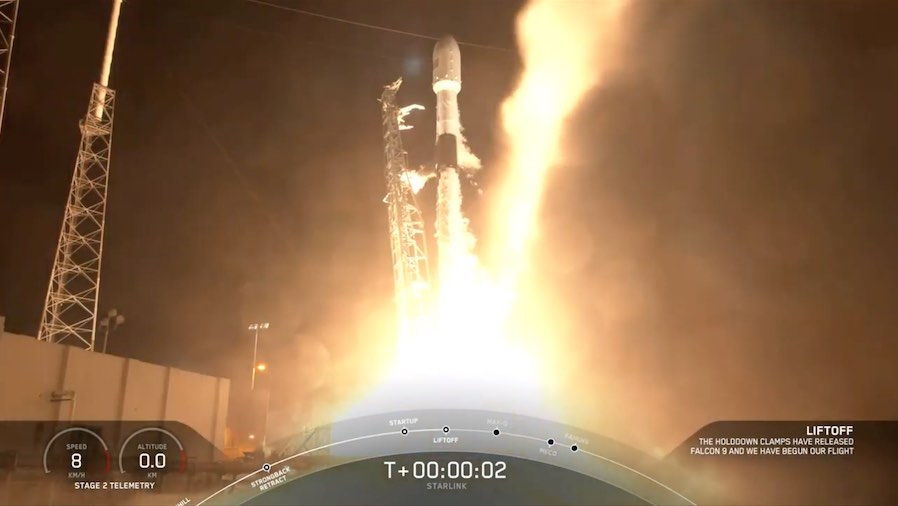
While Safyan would not disclose what Planet paid SpaceX to launch the six SkySats, SpaceX has published pricing for rideshare launch services on its website. The company lists a price as low as $1 million for a 440-pound payload on a rideshare to a polar sun-synchronous orbit.
“That’s incredibly competitive pricing,” Safyan said. “Coupled with the fact that the Falcon 9 is one of the world’s most reliable and well-flown vehicles out there, and they’re going to a variety of orbits very regularly, makes it a very attractive offering.”
The cost to purchase the entire capacity of an Electron rocket mission from Rocket Lab is around $5.7 million. Rocket Lab’s Electron launcher can carry up to 496 pounds (225 kilograms) to a low-altitude orbit, or 330 pounds (150 kilograms) to a higher sun-synchronous orbit.
Safyan said SpaceX provided Planet with parameters to integrate the SkySats on top of a flat-packed stack of Starlink satellites.
“SpaceX gave us the interface pattern, and then we designed a custom adapter plate in-house,” Safyan said. “We put together this adapter plate that would allow for three SkySats to fit onto that mounting. The SkySats sit at the top of the stack, and they get deployed as the first satellite deployment event, and Starlinks will follow thereafter.”
With the addition of three SkySats on top of the Starlink stack, SpaceX is only launching 58 Starlink platforms on Saturday’s mission, down from the typical number of 60 per launch.
The top-mounted SkySats separated from the rocket first Saturday after reaching a preliminary orbit inclined 53 degrees to the equator, deploying one-at-a-time at 30-second intervals beginning around-and-a-half minutes after liftoff.
Then the Falcon 9’s upper stage reoriented for the deployment of the 58 Starlink satellites, which separated from the rocket in one piece after the release of retention rods holding the flat-packed spacecraft onto the rocket.
Once the separation was initiated, the Starlink satellites — each weighing about a quarter-ton — were expected to slowly fly apart from each other as they prepare to unfurl solar arrays and activate their krypton ion drives.
The Starlink deployment occurred at T+plus 26 minutes when the Falcon 9 was flying outside the range of ground stations. SpaceX confirmed the separation sequence was initiated once the rocket flew over a tracking antenna at Diego Garcia in the Indian Ocean.
Saturday’s flight was also the first Falcon 9 launch to go ahead without a pre-flight test-firing of its nine Merlin first stage engines.
SpaceX was the only launch operator to perform static fire tests before every mission. Other companies, such as United Launch Alliance, conduct fueling rehearsals ahead of some missions, but most launch providers fuel their rockets for the first time on launch day.
It’s not clear whether SpaceX will perform static fire tests before future missions, or whether the company might only test-fire rockets making their first launch, or in preparation for missions with external customers, such as NASA or the U.S. military.
SpaceX is both the launch provider and the customer for a Falcon 9 launch with Starlink satellites. With 87 Falcon 9 flights in the books, the rocket is no longer a newly-designed launch vehicle. The Falcon 9 has logged more missions than any other U.S. launcher currently in service.
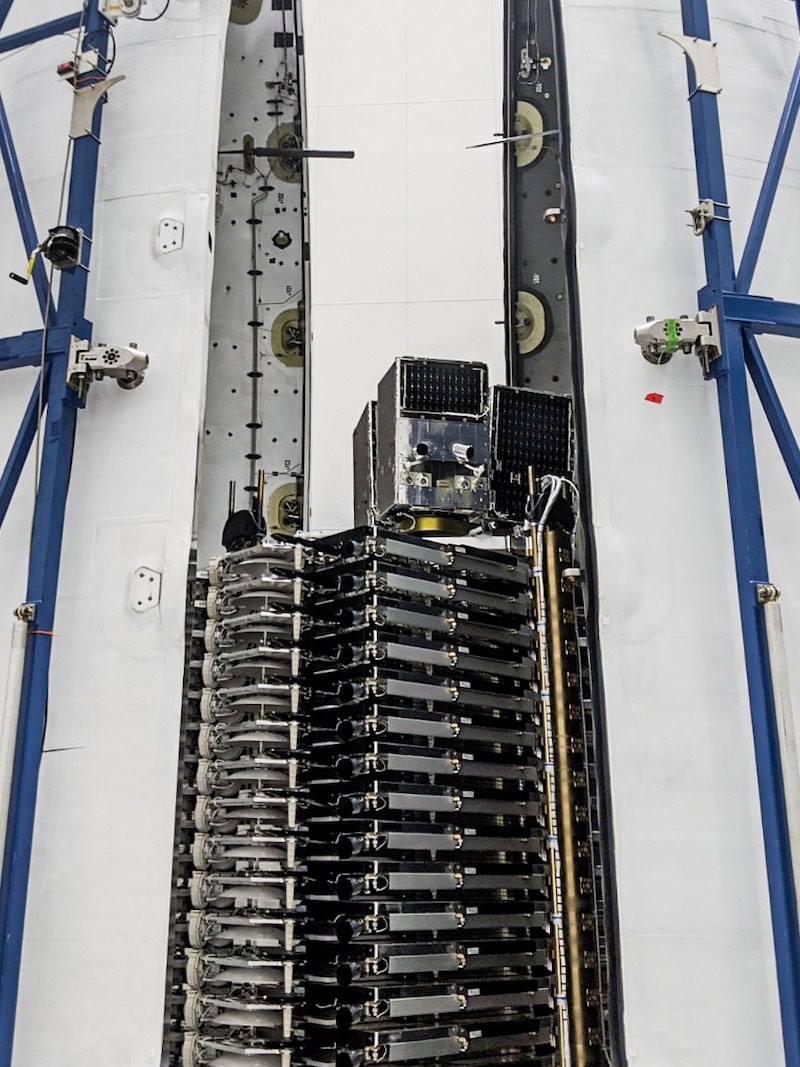
With the Starlink satellites successfully placed in orbit, their krypton propulsion systems will raise the spacecraft’s orbits to an operating altitude of 341 miles, or 550 kilometers, while SpaceX ground teams perform checkouts of each spacecraft.
With Saturday’s launch, SpaceX has launched 538 Starlink satellites since May 2019, extending the company’s record as the owner of the largest fleet of commercial satellites. Planet operates between 100 and 150 satellites, making it the owner of the second-largest constellation of commercial satellites.
Continuing its rapid launch pace, SpaceX aims to launch around 1,000 more Starlink satellites later this year and next year to begin offering worldwide Internet service.
Thousands more Starlink spacecraft could launch in the coming years to meet global demand, according to SpaceX.
SpaceX recently started soliciting information from prospective Starlink customers. Those who sign up can receive email updates on the Starlink network, those who submitted their zip codes will be “notified via email if beta testing opportunities become available in your area,” SpaceX said.
“Starlink is designed to deliver high-speed broadband Internet to locations where access has been unreliable, expensive, or completely unavailable,” SpaceX said. “Private beta testing is expected to begin later this summer, followed by public beta testing, starting with higher latitudes.”
Planet’s fleet includes more than 100 medium-resolution Dove and SuperDove CubeSats — each the size of a toaster oven — and 15 larger SkySats with sharper vision.
Built by Maxar, each of the SkySat satellites weighs around 242 pounds (110 kilograms) at launch. The SkySats are about the side of a mini-refrigerator.
The first 15 SkySat satellites launched into polar sun-synchronous orbits and fly in in north-south paths around Earth. Sun-synchronous orbits are popular for remote sensing and environmental satellites because they allow regular imaging of the Earth’s surface with the sun at the same angle.
Around half of the SkySats fly in orbits timed to fly overhead in the morning, and the other half soar over imaging targets in the afternoon, providing coverage of certain parts of the globe twice per day.
The six remaining SkySats are the last of a block of spacecraft ordered from Maxar, formerly known as SSL, by Skybox Imaging. Skybox was acquired by Google and renamed Terra Bella in 2014, then Planet acquired Terra Bella and the SkySat assets in 2017.
The three SkySat satellites launching Saturday, and another three set to launch on a following Starlink mission in July, will fly at a lower-inclination orbit inclined 53 degrees to the equator. Planet says the new satellites “will offer more targeted coverage and raw image capacity in key geographic regions.”
Safyan told Spaceflight Now the SkySats will use their own propulsion to maneuver from the Starlink injection orbit to an operating altitude of around 250 miles (400 kilometers).
At that altitude, the SkySats will be able to produce images of Earth at a resolution of less than 20 inches, or 50 centimeters. Planet announced it has also lowered the orbits of its SkySats already in space to allow the collection imagery of the same quality.
The first 15 SkySats have launched on a range of rockets, riding a Ukrainian-Russian Dnepr booster in 2013, a Russian Soyuz launcher in 2014, an Indian PSLV and a European Vega rocket in 2016, Northrop Grumman’s Minotaur-C rocket in 2017, and a Falcon 9 mission in 2018.
In addition to selling excess room on Starlink missions, SpaceX is planning as many as three dedicated Falcon 9 rideshare launches per year to sun-synchronous orbit. The first of the company’s dedicated rideshare missions is scheduled for December from Vandenberg Air Force Base in California.
The rideshare launches are similar to a sun-synchronous orbit multi-satellite launch from Vandenberg on a Falcon 9 rocket in December 2018. But that mission was managed by Spaceflight, a rideshare launch broker based in Seattle, which purchased the entire capacity of a Falcon 9 rocket and sold slots to commercial and government customers.
Now SpaceX itself is putting together rideshare launches, selling slots directly to satellite operators and brokers that then distribute mass and volume allotments to their customers.
Starlink launches take up the majority of the Falcon 9 rocket’s launch manifest this year. SpaceX has also sold capacity on the next Starlink launch, set for June 22, for two Earth-imaging satellites owned by BlackSky.
“SpaceX had a lot of different orbits we could choose from,” Safyan said. “That’s one of the advantages of going with a SpaceX rideshare because with other launch providers, they may be going to the orbit that you’re looking for, but with only one or two missions every now and again.
“But SpaceX is launching so frequently that if you’re looking for mid-inclination, you could go on a Starlink,” Safyan said. “If you’re looking for sun-synchronous, they have other rideshare opportunities. Other orbits are being offered as well. So it’s the number and frequency of opportunities that really makes a difference.”
The launch contract between SpaceX and Planet was signed just six months ago, Safyan said.
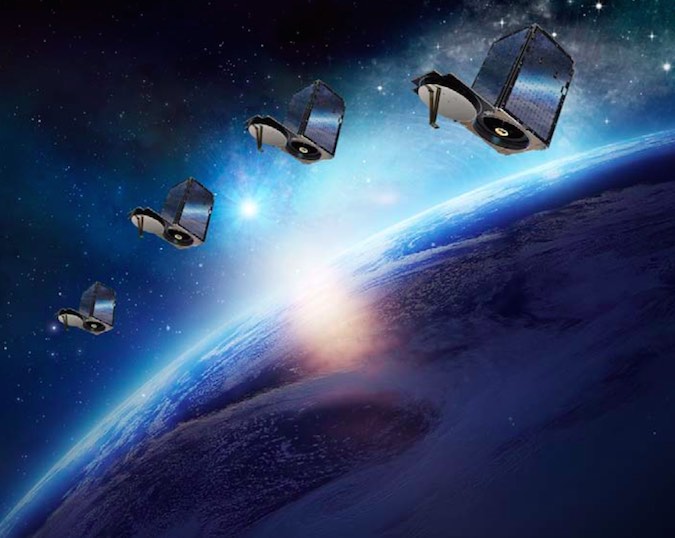
“We not only recognize that these Starlink launch opportunities were very cost-competitive on a very reliable launch vehicle, and going to the right orbit, but also the timing,” Safyan said. “We were ready to launch, and if we were to go to a dedicated launch service provider, then it could take 12 or 18 months for them to build their launch vehicle from scratch and fit it into their manifest.
“Launch companies typically don’t just have rockets sitting around on inventory that haven’t been assigned,” he said. “So being able to turn this around really quickly was another big advantage, and SpaceX is one of the few launch providers in the world that could do this so quickly.”
Planet could have launched all six of their remaining SkySats clustered together on same Starlink rideshare mission, but the company preferred to put them on two different rockets to be released into different orbital planes. That will help spread out the fleet for broader coverage, Safyan said.
“I think that there has been what appears to be kind of like a culture shift at SpaceX with respect to the smallsat market,” Safyan said. “Previously, I think that they were much more focused on bigger payloads and dedicated launch services, and they preferred to kind of outsource aggregating smaller payloads to other brokers. With their smallsat rideshare announcement, I think that was a turning point for SpaceX where they recognize that this is a real and important market, and that they wanted to be working directly with customers.
“That’s been a really great shift for us because SpaceX works very fast. They work at a very similar pace as we do. So we were able to put together this launch in a very quick timeframe.”
The SkySats are designed for six-year missions, according to Planet.
“That gives us a pretty long runway with respect to what these SkySats will be able to provide,” Safyan said. “We’re looking at the future of high-res at Planet. It’s still too early to talk about the details of that. But we will continue to offer both medium-res and high-res products to our customers.
“One of the promises that Planet always makes to its customers is that our products get better over time,” Safyan said. “We don’t like to rest on our laurels. We really like to listen to the market and understand what are they evolving needs, especially as we grow the customer base.
“It’s not just industries that are traditional users of remote sensing, like government agencies and agriculture,” he said. “There are newer markets that are being opened up in finance and insurance, so better understanding those market needs as well helps us inform how we develop the product going forward. Because we’re vertically-integrated, that gives us a really big advantage of being able to take customer feedback and actually incorporate that into satellite design and operations.”
Email the author.
Follow Stephen Clark on Twitter: @StephenClark1.


